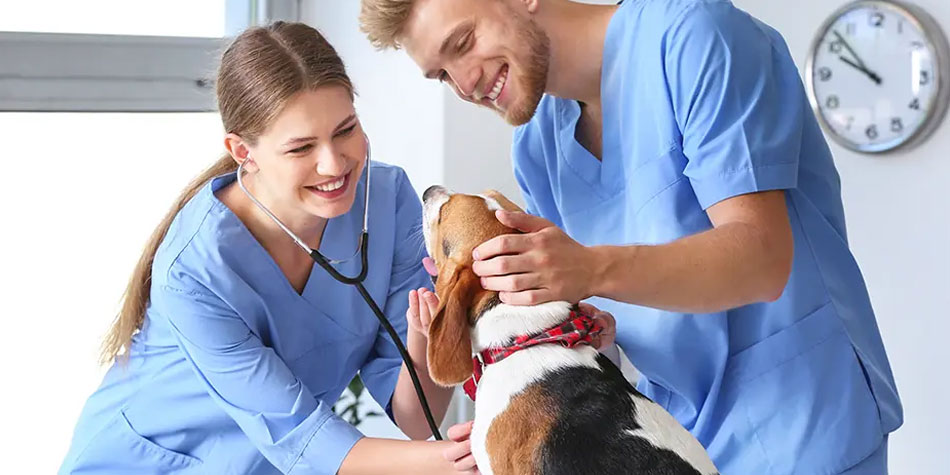
Become a Veterinary Assistant
Veterinary assistants are often the first person that pets and pet owners encounter when entering a veterinary office. They provide comfort and take charge of making sure office visits and procedures go smoothly for animals under veterinary care. With this Veterinary Assistant training course, created by Ed2Go and offered through SDSU Global Campus, you can turn your love of animals into a career entirely online in six months or less.
Course Objective
- Anatomy and physiology of the major organ systems
- Handling medical records and communicate with clients and coworkers
- Restraining animals for procedures, take vital signs, and bathe them
- Nutrition, vaccinations and administering medication
- Preparing prescriptions, taking blood samples and radiographs
Curriculum Outline
- GETTING STARTED
- WELCOME TO THE VETERINARY HOSPITAL
- GETTING READY FOR YOUR FIRST VISIT
- PHYSIOLOGY AND ANATOMY 1: DIRECTIONAL SIGNS AND THE SKELETAL SYSTEM
- PHYSIOLOGY AND ANATOMY 2: THE NERVOUS SYSTEM, ENDOCRINE SYSTEM, AND MUSCLES AND JOINTS
- PHYSIOLOGY AND ANATOMY 3: THE CIRCULATORY AND RESPIRATORY SYSTEMS
- PHYSIOLOGY AND ANATOMY 4: THE DIGESTIVE SYSTEM, UROGENITAL SYSTEM, LIVER, AND SPLEEN
- FRONT OFFICE DUTIES: RECORDS, CONFIDENTIALITY, AND CLIENT RELATIONS
- MORE FRONT OFFICE TIPS, AND DETERMINING AGE AND GENDER OF KITTENS AND PUPPIES
- CANINE RESTRAINT
- FELINE AND EXOTIC RESTRAINT
- THE PHYSICAL EXAMINATION: PROCEDURES, RESTRAINT, AND VITAL SIGNS
- EVERYDAY PROCEDURES FOR THE VETERINARY ASSISTANT
- WORKPLACE HAZARDS AND INFECTION CONTROL
- THE REPRODUCTIVE CYCLE AND STERILIZATION PROCEDURES
- VACCINOLOGY
- NUTRITION BASICS AND PRESCRIPTION FOODS
- PRESCRIPTIONS: PREPARING AND CALCULATING DOSES
- PRESCRIPTIONS: TYPES OF MEDICATIONS AND WHAT THEY DO
- GIVING MEDICATIONS
- THE EUTHANASIA PROCESS
- TAKING BLOOD SAMPLES
- INTERPRETING BLOOD TESTS AND HANDLING BLOOD
- URINE COLLECTION, HANDLING, AND INTERPRETATION
- TESTS: SEROLOGY, SCRAPINGS, SMEARS, FLOTATIONS, AND NECROPSIES
- RADIOGRAPHS AND PERSONAL SAFETY
- RADIOGRAPHIC POSITIONING
- PAIN RECOGNITION AND EMERGENCY CARE
- DENTISTRY: CHARTING, TOOTH DISEASE, AND DENTAL CARE
- EXTERNAL PARASITES: FLEAS, TICKS, MITES, AND MORE
- PARASITES OF THE GASTROINTESTINAL TRACT AND HEART
- POISONINGS IN PETS
- SURGERY 1: PREPARING THE PATIENT
- SURGERY 2: YOUR ROLE DURING AND AFTER
- UNDERSTANDING ANIMAL BEHAVIOR
- THE JOB SEARCH AND FUTURE OPPORTUNITIES
Prerequisites and Requirements
There are no prerequisites to take this course.
Registration and Enrollment
This course is 100% online. Start anytime.
Meet Your Instructor
Jeff Grognet
Jeff Grognet has been a companion animal veterinarian for 25 years. He was a pioneer in the field of veterinary assistant teaching, developing his first course more than 18 years ago. Due to the success of his veterinary receptionist/assistant courses, he expanded his teaching into other high-demand areas including pet first aid and alternative medical therapies for companion animals. He practices at a veterinary hospital and contributes regularly to several magazines.
California Job Outlook for Veterinary Assistants
Jobs for veterinary assistants are on the rise as more families add additional pets or bring pets into their homes for the first time. In fact, workforce analytics firm Burning Glass Technologies found that San Diego County is home to one of the fastest-growing job markets for veterinary assistants. It estimates that jobs for veterinary assistants will grow by 21% over the next decade. The U.S. Department of Labor estimates that an additional 2,700 veterinary assistants will be needed in California before 2029 - which means that 2,520 job openings will need to be filled each year in this field.
According to the Bureau of Labor Statistics, the average salary of a veterinary assistant is currently $29,930 per year. However, veterinary assistants in San Diego County earn $34,990 on average.
Veterinary Assistant FAQs
What Do Veterinary Assistant Responsibilities Involve?
The main job of a veterinary assistant is to support the veterinarian and other veterinary office staff, like veterinarian technicians, with basic tasks. Veterinary assistants will often greet patients and their owners when they enter a veterinary office. They feed, weigh, bathe and take the temperature of animals. They may also help give medication, clean cages and help restrain animals during treatment or other medical procedures as needed.
Do Veterinary Assistants Handle Administrative Duties?
Sometimes. Veterinary assistants may be asked to perform clerical work such as scheduling appointments and speaking with customers. They may also handle many logistical and operating duties, such as check-in, billing, and after-visit care. Duties will vary depending on the office you work in, but every task you undertake will help ensure the health and well-being of animals within the veterinary practice.
How Are A Veterinary Assistant And Veterinary Technician Different?
Veterinary assistants typically complete a certificate program that will teach them to perform basic duties within a veterinary practice. Veterinary technicians must complete formal education, such as a two-year associate degree accredited by the American Veterinary Medical Association (AVMA), and work as an animal nurse within veterinary practice.
Can I Go From A Veterinary Assistant To A Veterinary Technician Role?
Yes. Becoming a veterinary assistant is a great first step that will allow you to gain experience as you go back to school to complete your veterinary technician training and licensure. This path will help you better understand the industry, different specialties, and advanced duties required to work as a vet technician.
